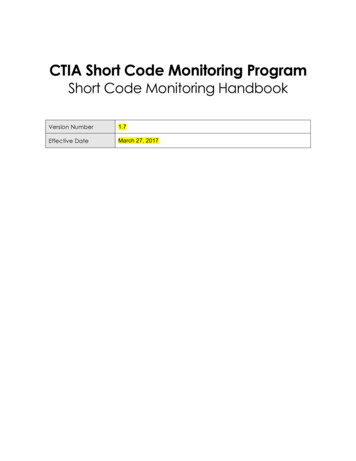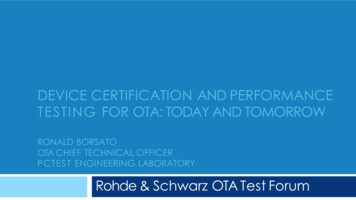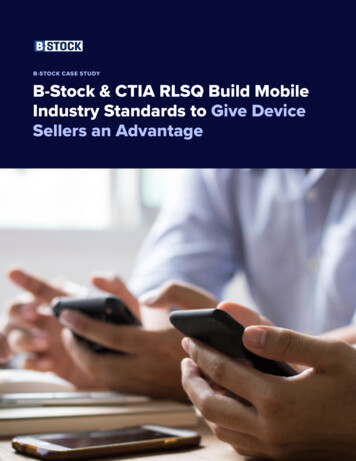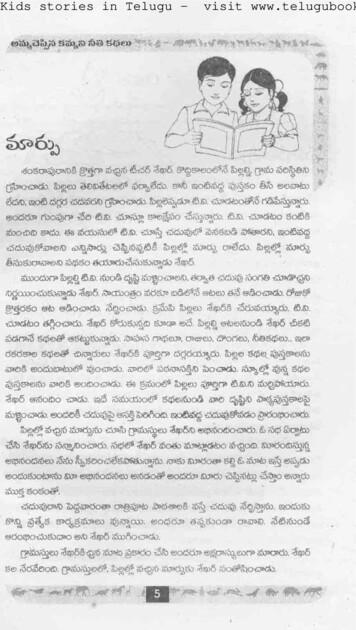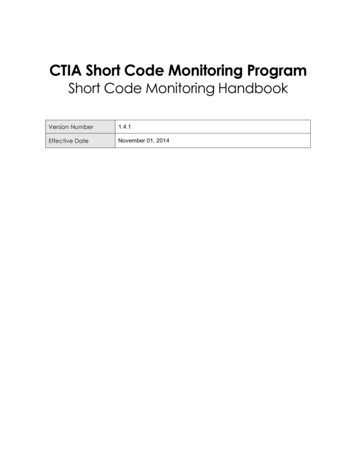
Transcription
CTIA Short Code Monitoring ProgramShort Code Monitoring HandbookVersion Number1.4.1Effective DateNovember 01, 2014
ContentsAbout This Handbook . 1References . 1Universal Compliance Principles . 2A.1Choice and Consent .2A.1.01Unsolicited Messages .2A.1.02Marketing Context .2A.1.03Opt-In .2A.1.04Handset Confirmation .3A.1.05Opt-Out.3A.2Customer Care .3A.3Program Content .3A.3.01Unapproved or Illicit Content .3A.3.02Controlled Substances .3A.3.03Sweepstakes and Contests .4A.3.04Content Delivery .4A.4Privacy Policy and Terms of Use .4A.5Program Records and Functionality .4A.5.01Customer Records .4A.5.02MO Message Processing .4Use Cases . 4A.6Single-Message Programs .5A.7Recurring-Messages Programs .6A.8Machine-to-Machine Programs .7A.9Political Donation Programs .7A.10Charitable Donation Programs .7A.11Free-to-End-User Programs .7A.12MMS Programs .7Carrier Onboarding . 7Compliance Audits . 9A.13Violation Notices .9A.14Schedule .9A.15Severity Levels .9A.16Communicating with the CTIA Compliance Care Team .10ii
A.17Retests.10A.18Appeals .10Reading the Audit Standards . 11Single-Message Programs . 12A.19Single-Message Program Advertising Audit Standards .12A.20Single-Message Program Message Flow Audit Standards .12Recurring-Messages Programs . 13A.21Recurring-Messages Program Advertising Audit Standards .13A.22Recurring-Messages Program Message Flow Audit Standards .13A.23Machine-to-Machine Program Audit Standards .14iii
IntroductionCTIA and its member companies work to protect consumers while fostering a competitive environment for shortcode programs. We aim to§ § § § § Provide consumers the best possible user experience;Honor consumer choice and prevent abuse of messaging platforms;Deliver flexible, lightweight guidelines that communicate compliance values clearly;Enable the short code industry to self regulate; andFacilitate enforcement measures, if necessary, to protect consumers quickly and consistently.The Short Code Compliance Handbook (the Handbook) guidelines lay the framework for achieving these goals,but CTIA reserves the right to take action against any short code program deemed to cause consumer harm.The Handbook is not intended as a comprehensive guide to compliance with laws and regulations that apply toshort code programs. Service providers are responsible for meeting legal requirements that apply to short codeprograms they offer, and CTIA and its members make no representation that meeting the guidelines in thisHandbook will be sufficient to assure legal compliance. Consultation with legal counsel is strongly recommended.ABOUT THIS HANDBOOKThis Handbook describes best practices for SMS, multimedia messaging service (MMS), and free-to-end-user(FTEU) short code programs with the primary goal of providing the best customer experience for end users.These guidelines do not attempt to define rules for programs that bill consumers. Guidelines are organizedaccording to use cases that apply. Examples of compliant programs are organized by use case in the appendices.Carriers reserve the right to implement their own short code requirements beyond the scope of this Handbook.However, all carriers have reviewed and accepted this document’s content.REFERENCESDrawing from experience working with short code programs, the guidelines evolve continually. Handbook v1.4 isbased on the following:§ § § § § § § Mobile Marketing Association’s Consumer Best Practices v7.0,CTIA Mobile Compliance Assurance Handbook v1.3,California Attorney General Kamala D. Harris’s “Privacy on the Go: Recommendations for the MobileEcosystem” best practices,Telephone Consumer Protection Act (TCPA),Florida Attorney General’s requirements for mobile content,A2P (application-to-person) community feedback, andCarrier requirements.1
Compliance FrameworkUNIVERSAL COMPLIANCE PRINCIPLESCTIA requires all short code programs to comply with a basic code of conduct that promotes the best possibleuser experience for all program types. As new uses for short codes emerge, these guiding principles should beconsidered in defining applicable rules. Services that comply technically with the letter of a specific rule, butviolate the letter or spirit these principles, might be subject to enforcement action.A.1CHOICE AND CONSENTMobile services are expected to deliver sufficient value so consumers elect to participate with full transparencyinto the delivery conditions.A.1.01UNSOLICITED MESSAGESUnsolicited spam messages may not be transmitted using short codes. Unsolicited messages are defined asfollows:§ § A.1.02Messages delivered without prior express written consent from the user or account holder, and1Messages sent after a user has opted out.MARKETING CONTEXTNo component of program advertising or messaging may be deceptive about the underlying program’sfunctionality, features, or content. All disclosures present in pre-purchase calls-to-actions, ads, terms andconditions, and messaging must remain clear and consistent throughout the user experience.A.1.03OPT-INMessages must be delivered to a user’s handset only after the user has opted in to receive them. A user mightindicate interest in a program in several ways. For example, a user might§ § § § Enter a phone number online,Click a button on a mobile webpage,Send an MO message containing an advertising keyword, orSign up at a point-of-sale location.Calls-to-action must be clear and accurate; consent must not be obtained through deceptive means. Enrolling auser in multiple programs based on a single opt-in is prohibited, even when all programs operate on the sameshort code.The opt-in for all short code programs must comply with all legal and regulatory requirements, including theTelephone Consumer Protection Act, 47 U.S.C. § 227, and the Federal Communication Commission’s rules under47 C.F.R. § 64.1200. For example, the express written consent obtained for any program that is “telemarketing”(as defined by 47 C.F.R. § 64.1200(f)(14)) must, unless exempt from the requirement, include the elements of“prior express written consent” set forth in 47 C.F.R. § 64.1200(f)(8). That rule requires a clear and conspicuousdisclosure informing the user that:§ 1By opting in, the user authorizes the seller to deliver or cause to be delivered to the user marketingmessages using an automatic telephone dialing system; andSending the user a single opt-out message acknowledging the opt-out request is the only exception to this rule.2
§ A.1.04The user is not required to opt in (directly or indirectly) as a condition of purchasing any property, goods,or services.HANDSET CONFIRMATIONHandset possession is confirmed implicitly when a user opts in from a mobile handset (e.g., keyword-based optins, mobile Web opt-ins); all other opt-ins for recurring services must include an additional step to confirm handsetpossession. Service providers may satisfy this requirement by sending an abbreviated opt-in MT messagesoliciting an MO response from the user. This message must include information sufficient to identify the program.A.1.05OPT-OUTFunctioning opt-out mechanisms are crucial for all text programs. Programs must always acknowledge andrespect customers’ requests to opt out of programs. However, depending on the use case, some programs arenot required to advertise opt-out instructions. Short code programs must respond to, at a minimum, the universalkeywords STOP, END, CANCEL, UNSUBSCRIBE, and QUIT by sending an opt-out message and, if the user issubscribed, by opting the user out of the program. Subsequent text, punctuation, and capitalization must notinterfere with opt-out keyword functionality.Recurring programs must also promote opt-out instructions at program opt-in and at regular intervals in content orservice messages, at least once per month. Opt-out information must be displayed in bold type on theadvertisement. A service may deliver one final message to confirm a user has opted out successfully, but noadditional messages may be sent after the user indicates a desire to cancel a service.A.2CUSTOMER CARECustomer care contact information must be clear and readily available to help users understand program detailsas well as their status with the program. Customer care information should result in users’ receiving help.Programs must always respond to customer care requests, regardless of whether the requestor is subscribed tothe program. At a minimum, the HELP keyword must return the program name and further information about howto contact service providers.A.3PROGRAM CONTENTAll content associated with short code programs must promote a positive user experience. Carriers regulatecertain types of content, including those listed below.A.3.01UNAPPROVED OR ILLICIT CONTENTNo programs associated with carrier brands or operating on the carrier networks may promote unapproved orillicit content, including the following:§ § § § Depictions or endorsements of violence,Adult or otherwise inappropriate content,Profanity or hate speech, andEndorsement of illegal or illicit drugs.Programs must operate according to all applicable federal and state laws and regulations. All content must beappropriate for the intended audience. Additional legal and ethical obligations apply when marketing to childrenunder age 13, and such programs might be subject to additional review carrier by carrier.A.3.02CONTROLLED SUBSTANCESPromotions of controlled substances might be subject to additional review carrier by carrier. Service providersmust receive explicit carrier approval before launching these types of programs. Marketing of hard alcohol andtobacco brands must either include robust age verification (e.g., electronic confirmation of age and identity) at opt-3
in or restrict promotions to age-verified locations (e.g., POS in bars). Mobile programs must not promote the useof controlled substances directly. Reference to the abuse of controlled substances is prohibited.A.3.03SWEEPSTAKES AND CONTESTSSweepstakes and contests might be subject to additional review carrier by carrier. Service providers must receiveexplicit approval before launching these types of programs. All sweepstakes must support a no-cost entrymethod. Service providers operating sweepstakes should seek legal guidance.A.3.04CONTENT DELIVERYUsers should be informed of the next steps to download and store new content immediately after opt-in. Contentmust be delivered correctly and must function as advertised.A.4PRIVACY POLICY AND TERMS OF USEService providers are responsible for protecting the privacy of user information and must comply with applicableprivacy law. Service providers should maintain a privacy policy for all programs and make it accessible from theinitial call-to-action. When a privacy policy link is displayed, it should be labeled clearly.Use cases might require different disclosures in the full terms and conditions. In all cases, terms and conditionsand privacy policy disclosures must provide up-to-date, accurate information about program details andfunctionality.A.5PROGRAM RECORDS AND FUNCTIONALITYService providers assume responsibility for maintaining accurate records in carrier systems and the CommonShort Code Administration (CSCA) registry. Service providers wishing to modify a program must submit changesto the carriers for review and must update relevant carrier records. Programs promoted in the market must matchthe programs approved.A.5.01CUSTOMER RECORDSAll opt-in and opt-out requests should be retained from the time a user initiates opt-in until a minimum of sixmonths after the user has opted out of a program. Service providers assume responsibility for managinginformation about deactivated and recycled numbers and must process this information within three businessdays of receipt. After porting a phone number between carriers, the user must opt in again to desired programs.Service providers must track opt-in information by individual user. Selling mobile opt-in lists is prohibited.A.5.02MO MESSAGE PROCESSINGAll mandatory keywords must be processed correctly, regardless of MO message format (e.g., keywords mustfunction whether sent by MMS or SMS). Service providers must scan MO message logs regularly to identify optout attempts and must terminate those subscriptions, regardless of whether the subscribers used the correct optout keywords or methods.USE CASESBecause short code programs vary greatly, depending on their intended purpose, Handbook v1.4 was designedwith different use cases in mind. Please note that all use cases must comply with the Universal CompliancePrinciples in addition to the specific guidelines described here.4
A.6SINGLE-MESSAGE PROGRAMSSingle-message programs, or “one-off” programs, deliver a one-time message in response to user opt-inrequests. Examples of single-message programs include but are not limited to the following:§ § § § Informational alert,Purchase receipt,Delivery notification, andTwo-factor authentication.An example of a compliant single-message call-to-action and associated message flow appears in Appendix A.Exhibit 1 displays a quick reference guide for a single-message program.Exhibit 1: SINGLE-MESSAGE USE CASE QUICK REFERENCE GUIDEDescriptionCall-to-ActionRequirementsThe call-to-action for a single-messageprogram can be simple. The primary purposeof disclosures is to ensure a consumerconsents to receive a message andunderstands the nature of the program.§ § Terms andConditionsComprehensive terms and conditions may bepresented in full beneath the call-to-action, orthey may accessible from a link or a popuppresented near the call-to-action.§ § § § Opt-InThe consumer must actively opt into singlemessage programs.Although single-message programs are notrequired to display HELP and STOPkeywords, they should support HELP andSTOP commands, as described in theUniversal Compliance Principles.§ Message Flow§ § Service descriptionComplete terms and conditions or linkto terms and conditionsPrivacy policy or link to privacy policy“Message and data rates may apply”disclosureProgram identificationService descriptionCustomer care contact information“Message and data rates may apply”disclosureConsumer’s affirmative opt-inConfirmation MT§ Program or product nameHELP MT§ Program or product name§ Additional customer care contactinformationOpt-Out MT§ Program or product name§ Confirmation that no furthermessages will be delivered5
A.7RECURRING-MESSAGES PROGRAMSShort code programs with recurring messages advertise via the following media:§ § § § § Online,Print publications,Mobile devices,Radio, andTV.A user opts into recurring messages by texting a keyword to the program’s short code, entering his or her mobilephone number online, or agreeing to receive text messages in apps or in person. Examples of recurringmessages programs include but are not limited to the following:§ § § Content or informational alert subscriptions (e.g., horoscopes, news, weather),Flight status notifications (multiple messages), andMarketing and loyalty campaigns.An example of a compliant recurring-messages call-to-action and associated message flow appears inAppendix B.Exhibit 2 displays a quick reference guide for a recurring-messages program.Exhibit 2: Recurring-Messages Use Case Quick Reference GuideDescriptionRequirementsCall-to-ActionBecause of their ongoing touch points withconsumers, recurring-messages programsrequire the most disclosures among usecases. The primary purpose of disclosures isto ensure the consumer consents to receivemessages and understands the nature of theprogram.Terms andConditionsComprehensive terms and conditions mightbe presented in full beneath the call-toaction, or they might be accessible from alink or a popup presented near the call-toaction.Opt-InRecurring-messages programs should sendtwo messages for all non-mobile opt-ins.Message FlowUnlike other use cases, recurring-messagesprograms must advertise HELP and STOPcommands. They also have the mostrequirements for service messaging.Service descriptionService delivery frequency orrecurring-messages disclosure§ Complete terms and conditions or linkto complete terms and conditions§ Privacy policy or link to privacy policy§ “Message and data rates may apply”disclosure§ Program identification§ Service delivery frequency orrecurring-messages disclosure§ Service description§ Customer care contact information§ Opt-out instructions in bold type§ “Message and data rates may apply”disclosure§ Consumer’s affirmative opt-in§ Handset verification for non-mobileopt-in (i.e., MO from consumer’shandset)Opt-In MT (non-mobile opt-in)§ Program or product name§ HELP information§ Response command or PINConfirmation MT§ Program or product name§ Opt-out information§ Customer care contact information§ § 6
Product quantity or recurringmessages disclosure§ “Message and data rates may apply”disclosureHELP MT§ Program or product name§ Additional customer care contactinformationOpt-Out MT§ Program or product name§ Confirmation that no furthermessages will be delivered§ A.8MACHINE-TO-MACHINE PROGRAMSMachine-to-machine (M2M) short code programs, which should never interact with consumers, only need keep anupdated program brief on file with the CSCA and the carriers.A.9POLITICAL DONATION PROGRAMSPremium short code programs that solicit political donations are subject to additional regulations, available ns-wireless-carrierbill. Premium political donation programs also must conform to the premium SMS guidelines and audit standardsin the Handbook v1.3.A.10 CHARITABLE DONATION PROGRAMSPremium short code programs that solicit charitable donations are subject to additional regulations, available -bill. In addition,premium charitable donation programs must to conform to the premium SMS guidelines and audit standards inthe Handbook v1.3.A.11 FREE-TO-END-USER PROGRAMSFTEU programs are subject to the same requirements as standard rate short code programs. Recurringmessages FTEU programs that market to consumers are subject to all subscription marketing requirements,except disclosing that “message and data rates may apply.”A.12 MMS PROGRAMSMMS programs are subject to the same requirements per use case as SMS programs. All mandatory keywordsmust be processed correctly, regardless of MO format (e.g., keywords must function whether sent by MMS orSMS). Service providers must scan MO logs regularly to identify opt-out attempts and must terminate thosesubscriptions, regardless of whether the subscribers used the correct opt-out keywords or methods.Additional best practices specific to MMS will be released in an upcoming version of this Handbook.CARRIER ONBOARDINGCTIA is most concerned with mobile programs as they interact with consumers through advertising and textmessaging. However, several facets of SMS programs happen behind the scenes. Recommended best practicesfor onboarding new programs follow.7
Carriers may maintain individual playbooks tailored to their customers’ needs and must sometimes respond toemerging risks that fall outside the Handbook. Please refer to carriers’ playbooks for onboarding informationregarding§ § § § § Program certification and migration processes,Program brief details,Advertising of controlled substances,Sweepstakes approval processes, andMarketing to children.8
In-Market Monitoring GuideCOMPLIANCE AUDITSThe CTIA Compliance Assurance Solution employs data gathered via in-market monitoring. When calls-to-actionare deployed in market, the live programs are captured and audited. This method is more effective than programbrief review or routine keyword testing because audits reflect the user experience that real consumers encounterwhen they interact with these programs in market.CTIA issues audits weekly for standard rate short codes leased with the CSCA. Audits performed by CTIA areavailable to all major U.S. carriers, and CTIA compliance metrics can be incorporated into individual carriercompliance policies.A.13 VIOLATION NOTICESCTIA distributes color-coded Program Violation Notices and Message Flow Violation Notices, known informally asfailure forms, each week. At the top of a violation notice is a unique audit number and the short code, serviceprovider, and aggregator or aggregators as well as the notice date and the cure date. Individual violations areclassified as Severity 0, Severity 1, or Severity 2, based on their potential for consumer harm, with Severity 0 themost extreme. These violations are based on the compliance guidelines outlined in the Compliance Frameworksection of this Handbook. Taking the severity level of the gravest violation cited, a failed audit must be resolved inthe appropriate timeframe (i.e., before or on the cure date).A.14 SCHEDULECTIA compiles and generates violation notices each Monday for audits performed the previous week, and auditsare published as soon as they become available. Although audits might be available for review earlier, the officialnotice date from which the cure date is calculated is 12:00 P.M. Eastern Time on Tuesday.A.15 SEVERITY LEVELSAll Program Violation Notices and Message Flow Violation Notices are assigned severity levels based on theextent to which the associated findings might harm consumers. Cure dates and penalties vary based on severity,as detailed in Exhibit 3.Exhibit 3: Violation Notice Severities DescriptionDefinitionSeverity 0Severity 1Cure DateExtremeconsumer harmImmediateSeriousconsumer harm5 business daysPenaltiesViolation NoticeCTIA: Immediate registry suspensionCarriers: Case by case; immediatesuspension or termination possibleCTIA: Unresolved audits; possibleregistry suspensionCarriers: Case by caseSeverity 2Moderateconsumer harm5 business daysCTIA: Case by caseCarriers: Case by case9
A.16 COMMUNICATING WITH THE CTIA COMPLIANCE CARE TEAMOn receiving a violation notice, service providers may communicate with compliance@psmsindustrymonitor.comby replying to the compliance notification email. The reply, which must preserve the email subject field, shouldpose specific questions or outline issues relating to the cited violations. The CTIA Compliance Care Team (CareTeam) responds promptly to all messages. Although Care Team specialists are unable to preapprove compliantdesigns, they assist service providers as much as possible with understanding how to resolve violations and closetheir audits.A.17 RETESTSWithin the prescribed period following issuance of a violation notice, the responsible aggregator or serviceprovider must confirm by replying to the initial email (compliance@psmsindustrymonitor.com) that it has madechanges to or has removed from market the offending ad or message flow. If the Care Team fails to receiveconfirmation or the service provider fails to take the actions required, the short code is subject to further action.In the case of TV and print ads with longer run cycles, aggregators and service providers may submit a retestrequest for a rerelease date. Retest requests must be made in good faith, with a clear explanation of the changesimplemented. Audits at this status are categorized as Pending Retest.A.18 APPEALSAggregators and service providers that believe they have a valid claim may challenge an audit by responding tocompliance@psmsindustrymonitor.com before the cure date noted on the violation notice. The email messageshould explain why the service provider deems the audit incorrect. Appeals must pertain to the application ofviolations cited on the specific audit in question.10
READING THE AUDIT STANDARDSThe following pages display tables of audit standards by use case. Advertising audit standards apply to all mediahosting calls-to-action for short code programs; message flow audit standards apply to required servicemessages. Message categories for which specific standards apply are marked with an “x” in the tables. Pleaserefer to the glossary below for help with unfamiliar terms.Opt-InThe first message customers receive in a double opt-in customer experience. The opt-inmessage contains a PIN or a response command to verify the customer’s messagingpreferences. This message is required only for subscription programs, but, if sent,should comply with the Universal Compliance Principles.Conf.(Confirmation)The second message customers receive in a double opt-in customer experience. Theprogram enrollment confirmation message contains program details. In some use cases,the confirmation message is the first message customers receive.HELPThe message service providers send after customers text the HELP keyword. Shortcodes should reply with additional contact information to customer requests for help.Opt-OutThe message service providers send after customers t
Drawing from experience working with short code programs, the guidelines evolve continually. Handbook v1.4 is based on the following: ! Mobile Marketing Association's Consumer Best Practices v7.0, ! CTIA Mobile Compliance Assurance Handbook v1.3, . After porting a phone number between carriers, the user must opt in again to desired programs.
